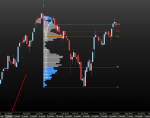Hi Guys
is anyone works with Volume Profile here?
Can we trust this tool when we put it on a daily and above charts? because all studies that have "Tick Interval" option in there they work for timeframes less than daily (Tick data) and they are not even shown on daily and above charts , but Volume profile although has "Tick Interval" in it it is shown on every timeframe. Just i want to make sure i can use it.

thanks
is anyone works with Volume Profile here?
Can we trust this tool when we put it on a daily and above charts? because all studies that have "Tick Interval" option in there they work for timeframes less than daily (Tick data) and they are not even shown on daily and above charts , but Volume profile although has "Tick Interval" in it it is shown on every timeframe. Just i want to make sure i can use it.

thanks
